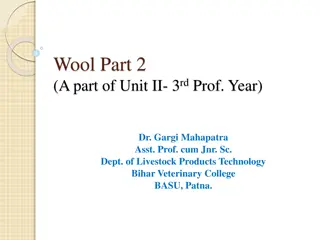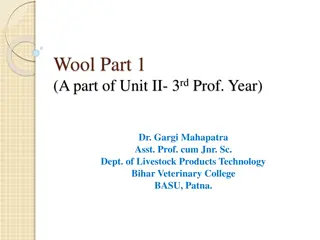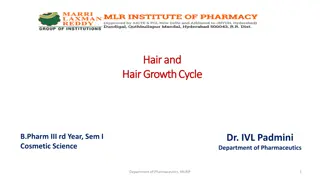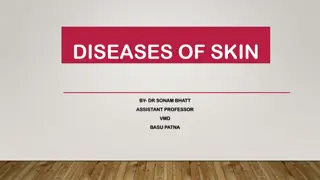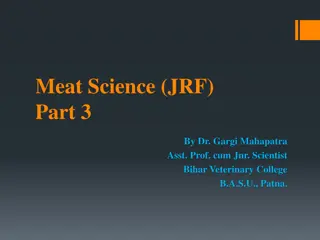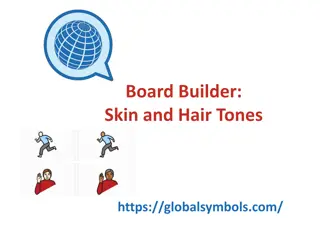Understanding Diseases of the Hair, Wool, Follicles, and Skin Glands
Diseases of the Hair, Wool, Follicles, and Skin Glands covers various conditions like alopecia, hypotrichosis, and the failure of follicles to develop or produce fibers. It discusses causes, pathogenesis, clinical findings, and treatments related to hair and skin issues. The content delves into congenital and acquired reasons for hair loss, metabolic alopecia, and chemical depilation. Images illustrate different conditions for better understanding.
Download Presentation

Please find below an Image/Link to download the presentation.
The content on the website is provided AS IS for your information and personal use only. It may not be sold, licensed, or shared on other websites without obtaining consent from the author. Download presentation by click this link. If you encounter any issues during the download, it is possible that the publisher has removed the file from their server.
E N D
Presentation Transcript
Diseases of the Hair, Wool, Follicles, and Skin Glands By Dr. Hussein AlNaji
AlopeciaAnd Hypotrichosis Etiology Alopecia and hypotrichosis are defined as lack of hair in any quantity on a normally haired body surface. In contrast to alopecia, which describes hair loss of a skin surface with previously normal hair growth. Hypotrichosis refers to a condition where there was no hair growth or abnormally low hair growth in the first place.
1. Failure of Follicles to Develop Congenital hypotrichosis Hypotrichosis in piglets without dental dysplasia 2. Loss of Follicles Cicatricial alopecia as a result of scarring after deep skin wounds that destroy follicle. 3. Failure of the Follicle to Produce a Fiber a. Congenital such as Inherited symmetric alopecia and Congenital hypotrichosis. b. Acquired such as Neurogenic alopecia as a result of peripheral nerve damage and Infection in the follicle.
4. Loss of Preformed Fibers a. Dermatomycoses ringworm b. Mycotic dermatitis in all species. c. Metabolic alopecia subsequent to a period of malnutrition or severe illness (e.g., calves having suffered severe diarrhea) d. Alopecia of calves fed milk replacer containing fats of nonanimal origin (whale, palm, or soya oil). e. Traumatic alopecia as a result of excessive scratching or rubbing associated with louse, tick, or itch-mite infestations; rubbing against. f. Poisoning by thallium, selenium, arsenic and mercury.
Pathogenesis 1. In inherited hair defects the underlying cause can be disturbed hair follicle formation resulting in a reduced hair follicle quantity or disturbed functionality of hair follicles that are present in adequate numbers. 2. Noncicatricial alopecia is caused by reversible trauma to previously functional hair follicles by inflammation or mechanical trauma, which results in disturbed or interrupted synthesis in the hair bulb and ensuing shedding or fracture of hairs.
3. Cicatricial alopecia is characterized by an irreversible destruction of hair follicles most commonly caused by physical, chemical, or thermal injury or severe inflammation. 4. Chemical depilation produced by cytotoxic agents, such as cyclophosphamide, occurs as a result of induced cytoplasmic degeneration in some of the germinative cells of the bulb of the wool follicle. The alteration in cell function is temporary, so that regrowth of the fiber should follow.
Clinical Findings 1. When alopecia is a result of breakage of the fiber, the stumps of old fibers or developing new ones may be seen. 2. When fibers fail to grow, the skin is shiny and in most cases is thinner than normal. 3. In cases of congenital follicular aplasia, the ordinary covering hairs are absent. 4. Absence of the hair coat makes the animal more susceptible to the effects of sudden changes of environmental temperature. 5. There may be manifestations of a primary disease and evidence of scratching or rubbing.
Clinical Pathology If the cause of the alopecia is not apparent after the examination of skin scrapings or swabs, a skin biopsy will reveal the status of the follicular epithelium. TREATMENT Primary treatment consists of removing the causes of trauma or other damage to fibers. In cases of faulty follicle or fiber development treatment is not usually attempted.
Achromotrichia Achromotrichia is a deficient pigmentation in hair or wool fiber, which may manifest as follows: 1. Bands of depigmentation in an otherwise black wool fleece are the result of a transitory deficiency of copper in the diet. 2. Cattle on diets containing excess molybdenum and deficient copper show a peculiar speckling of the coat caused by an absence of pigment in a proportion of hair fibers. The speckling is often most marked around the eyes, giving the animal the appearance of wearing spectacles.
LeukodermaAnd Leukotrichia Several skin diseases of the horse are characterized by an acquired loss of melanin pigment in the epidermis or hair. Melanocytes in the epidermis and those in the hair bulbs are frequently affected independently. Leukotrichia occurs when the melanocytes in the hair bulbs lose their normal amount of melanin pigment. When the melanocytes in the epidermis are affected and the skin loses normal pigmentation, the abnormality is leukoderma. Whereas leukotrichia can be observed as a single entity, leukoderma is most commonly associated with leukotrichia.
Etiology The etiology and pathogenesis of leukoderma are unknown, but trauma, inflammation, autoimmune reactions against melanocytes, local injections with epinephrine- containing local anesthetics, and defects of the autonomous nervous system.
Seborrhea Etiology: The etiology of seborrhea is still not understood. Historically seborrhea was considered to be the result of excessive secretion of sebum onto the skin surface. In large animals it is always secondary to dermatitis or other skin irritations that result in excessive crusting, scaling, or oiliness, such as the following: 1. Greasy heel of horses, including infection with S. hyicus 2. Greasy heel of cattle. 3. Flexural seborrhea of cattle 4. Besnoitiosis of cattle associated with Besnoitia besnoiti
CLINICAL FINDINGS In primary seborrhea there are no lesions, only excessive greasiness of the skin. The sebum may be spread over the body surface like a film of oil or be dried into crusts, which can be removed easily. Sebaceous glands may be hypertrophied.
Flexural Seborrhea 1. Etiology: Flexural seborrhea is most common in young periparturient dairy cows. 2. Clinical signs: Severe inflammation and a profuse outpouring of sebum appear in the groin between the udder and the medial surface of the thigh or median fissure between the two halves of the udder. 3. Extensive skin necrosis follows, causing a pronounced odor of decay, which may be the first sign observed by the owner. 4. Irritation may cause lameness, and the cow may attempt to lick the part. Shedding of the oily, malodorous skin leaves a raw surface beneath; healing follows in 3 to 4 weeks.
Greasy Heel of Cows Etiology: Cows grazing constantly irrigated, wet pastures or in very muddy conditions in tropical areas. 1. Clinical signs: May develop local swelling, with deep fissuring of the skin and an outpouring of vile-smelling exudate on the back of the pastern of all four feet but most severely in the hind limbs. 2. Affected animals are badly lame, and their milk yield declines sharply. 3. Treatment: Moving the cows to dry land and treating systemically with a broad-spectrum antibiotic effects a rapid recovery.
Greasy Heel of Horses (Scratches) 1. Etiology: Greasy heel occurs mostly on the hind pasterns of horses that stand continuously in wet, unsanitary stables. It has been suggested that secondary infections associatedwith either S. aureus and D. congolensis may be causative factors. Dermatophytosis, chorioptic mange, and photosensitization are also possible causative factors.
1. Clinical signs: Lameness and soreness to touch are a result of excoriations called scratches on the back of the pastern that extend down to the coronary band. 2. The skin is thick and greasy; if neglected, the condition spreads around to the front and up the back of the leg. This involvement can be severe enough to interfere with normal movement of the limb. Clinical Pathology The diagnosis is based on the clinical presentation and on ruling out other skin conditions resulting in abnormal cornification and keratinization.
Treatment 1. With secondary seborrhea the primary objective of treatment must be to resolve the underlying cause. 2. Topical and symptomatic treatment of the affected skin. 3. Seborrheic shampoos and lotions can either be keratolytic or keratoplastic. Emollients are useful after washing the skin to rehydrate, lubricate, and soften the skin. 5. In severe cases associated with pyoderma or even skin necrosis, the use of local and systemic broad-spectrum antibiotics may be indicated.


